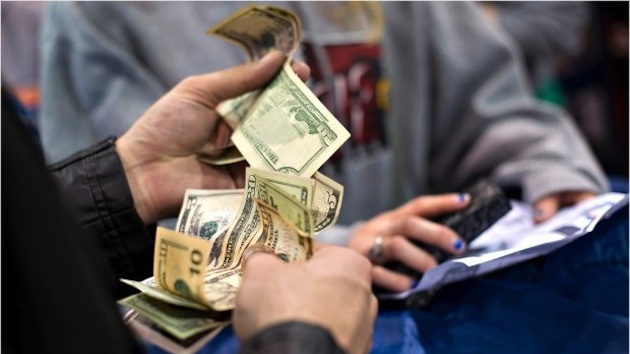

A shopper organizes his cash before paying for merchandise at a Best Buy Co. store in Peoria, Illinois, U.S., on Friday, Nov. 23, 2012. (Photo: Daniel Acker/Bloomberg/Getty)
The Commerce Department Thursday said U.S. consumer spending rose by 0.4 percent in March, but personal incomes remained flat. The increase fueled by purchases of durable goods, and up from 0.2 percent in February. While households increased purchases of automobiles, spending on utilities decreased.
Economists polled by Reuters had forecast consumer spending, which accounts for more than two-thirds of U.S. economic activity, gaining 0.5 percent last month.
When adjusted for inflation, consumer spending rose by just 0.3 percent in March after being flat the prior month. However, the gain was included in Wednesday’s abysmal first-quarter gross domestic product report, which showed the economy grinding to a near complete halt. GDP grew at only a 0.2 percent annual pace after a mediocre 2.2 percent growth rate in the fourth quarter.
The Federal Reserve on Wednesday acknowledged the first quarter stall, but publicly tried to dismiss the report as an anomaly. Yet, actions speak louder than words, and the timing and trajectory of interest rate hikes are expected to be postponed to a later date.
Meanwhile, despite the gains in spending, Americans’ personal incomes remained flat. Because savings slipped, it is clear they were tapped to account for the increase in spending. The savings rate remained at high levels, which economists hope will fuel future consumer spending.
Excluding food and energy, prices rose 0.1 percent for a third straight month. The so-called core PCE price index increased 1.3 percent in the 12 months through March.
The most damning journalistic sin committed by the media during the era of Russia collusion…
The first ecological study finds mask mandates were not effective at slowing the spread of…
On "What Are the Odds?" Monday, Robert Barnes and Rich Baris note how big tech…
On "What Are the Odds?" Monday, Robert Barnes and Rich Baris discuss why America First…
Personal income fell $1,516.6 billion (7.1%) in February, roughly the consensus forecast, while consumer spending…
Research finds those previously infected by or vaccinated against SARS-CoV-2 are not at risk of…
This website uses cookies.